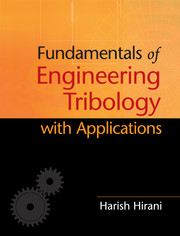Book contents
- Frontmatter
- Dedication
- Contents
- List of Figures
- List of Tables
- Preface
- Acknowledgments
- Nomenclature
- 1 Introduction
- 2 Friction, Wear and Boundary Lubrication
- 3 Lubrication of Bearings
- 4 Hydrodynamic Thrust Bearing
- 5 Hydrostatic and Squeeze Film Lubrication
- 6 Elasto–Hydrodynamic Lubrication
- 7 Gas (Air) Lubricated Bearings
- 8 Mixed Lubrication
- 9 Tribological Aspects of Rolling Motion
- 10 Tribological Aspects of Gears
- Index
- References
1 - Introduction
Published online by Cambridge University Press: 05 March 2016
- Frontmatter
- Dedication
- Contents
- List of Figures
- List of Tables
- Preface
- Acknowledgments
- Nomenclature
- 1 Introduction
- 2 Friction, Wear and Boundary Lubrication
- 3 Lubrication of Bearings
- 4 Hydrodynamic Thrust Bearing
- 5 Hydrostatic and Squeeze Film Lubrication
- 6 Elasto–Hydrodynamic Lubrication
- 7 Gas (Air) Lubricated Bearings
- 8 Mixed Lubrication
- 9 Tribological Aspects of Rolling Motion
- 10 Tribological Aspects of Gears
- Index
- References
Summary
Defining Tribology
What is tribology?
Tribology, derived from the Greek word ‘Tribos’, is a science that deals with friction, lubrication and wear in all contacting pairs. Tribological knowledge helps in reducing the requirement of maintenance and improves reliability of interacting machine components. Essence of tribology at design stage yields substantial economic benefits.
Need of tribology as a separate subject
Friction, wear and lubrication have been taught in science and engineering classes, but at a rudimentary level. It means empirically derived trends (friction force is proportional to loading force, static friction is greater than kinetic friction, viscous friction in a fluid is proportional to the normal contact force, etc.,) are often the only predictive tools available. These approaches have the drawbacks of being predictive only over a limited range of parameters. Since the underlying physical mechanisms are not well understood, often one does not even know the important parameters or the range over which the observed trends are valid. This poor predictive power has given birth to the field of tribology, being pursued in many scientific quarters as a complete subject.
Most tribological phenomena are inherently complicated and interconnected, making it necessary to understand the concepts of tribology in detail. For example, calculations of contact stresses and surface temperature during sliding require understanding of ‘solid mechanics’. Similarly, study of lubricant film formed between different geometric shapes of interacting surfaces demands knowledge of fluid mechanics. Mechanical wear at atomic and micro scales involves thorough understanding of material science. Formation of boundary layer on the solid surface demands information about chemistry. In short, integration of knowledge from multifaceted disciplines (solid mechanics, fluid mechanics, material science, chemistry, etc.,) is essential, and therefore, a separate subject is required.
Solid Mechanics
Solid mechanics governs the response of solid material to applied force, as shown in Fig. 1.1.2.1.
• Based on storage of energy and loss modulus, materials can be categorized as elastic, visco–elastic and plastic materials. Behaviour of these materials with fluid at the interface of contacting solids affects the performance of the system.
• Surface roughness and real area of contact between surfaces play very important role. Neither zero roughness nor high roughness is desirable. Real area of contact may be 10–50 percent of apparent area. So to achieve high performance from contacting surfaces, account of roughness and real area of contact is essential. […]
- Type
- Chapter
- Information
- Publisher: Cambridge University PressPrint publication year: 2016



